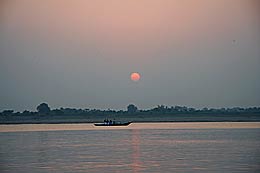 |
Varanasi is said to be the oldest inhabited city in the world.
There are supposed to be 2,000 temples in Varanasi. It is
125km east of Allahabad, on the bank of the Ganges.
|
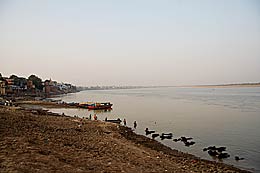 |
Many older people come to Varanasi to die and to be burned at
the burning ghats along the river. It is believed that
anyone who dies in Varanasi attains moksha (liberation). It
is said that being burned at Varanasi adds to the pious
credits of someone, therefore many bodies are brought here
to be cremated. Many widows come here to die.
|
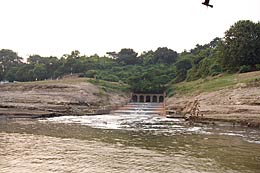 |
The name Varanasi most likely stems from the two rivers,
Varuna and Asi, which join the Ganges on the north and south
borders of the city.
|
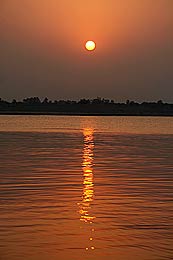 |
It is said that the first Siva Jyotirlinga, the fiery pillar
of light, came through the earth here and flared into the
sky. Therefore Varanasi is also called Kasi, "City of
Light." Kashi is mentioned in the Mahabharata, Ramayana,
Srimad Bhagavatam, and the Puranas, which date back 5,000
years, as the foremost city of Siva. The Muslims gave it the
name Benares. At Independence, the old name, Varanasi, was given
to the city again.
|
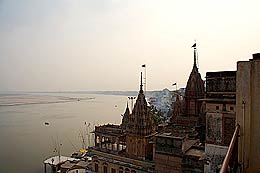 |
The Ganges, which normally flows southeast, reverses its
course and flows north for a while at Varanasi, which is
considered very auspicious. There is a five-mile parikrama
path that goes around this sacred city. There are 81 bathing
ghats and other holy kunds, or sacred tanks.
|
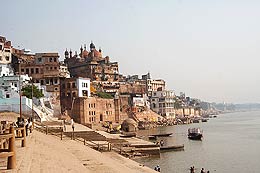 |
Many saints and sages have come to Varanasi including Sri
Caitanya Mahaprabhu, the Buddha, Sankaracarya, and Sri
Ramanuja. Sri Caitanya met Sanatana Gosvami here and
converted Prakasananda Sarasvati and his followers here.
|
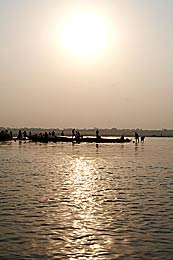 |
For many, it is one of
the highlights of a trip to India to get on a boat at 6 am and
see the city on the waters of the Ganges at sunrise. |
 |
Six o'clock in the morning is the best time to visit the
waterfront. It is a good idea to rent your own boat and not
go with many other people.
|
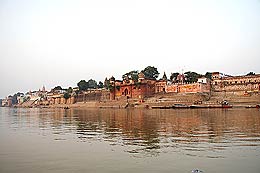 |
In upper part of town used to be the Maharaja of Varanasi's
palace...
|
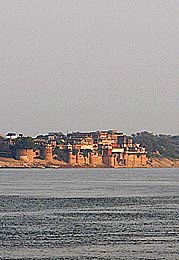 |
..but he has later built his residence on the opposite side of
the river. It is called Ramnagar.
|
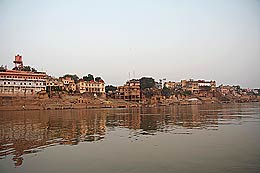 |
Hariscandra Ghat
Bodies are brought from thousands of kilometers away to be burned here.
This ghat is named after King Hariscandra, who is said to have had to
work as a Dom (caretaker of the crematorium) in order to keep his word.
Kings Hariscandra was famous for never refusing a guest and never
telling a lie...
|
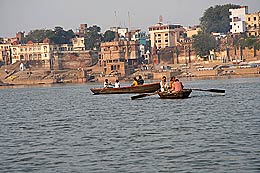 |
...He was a worshiper of Brahma. Indra told Brahma that he
believed that Hariscandra's devotion was not as strong as he
made it appear to be. So in order to prove that it was,
Brahma disguised himself as a Brahmin priest and asked the
king for his entire kingdom. Hariscandra gave it. In order
to give the priest payment (daksin) for performing some
rituals the king became a worker at the crematorium at this ghat...
|
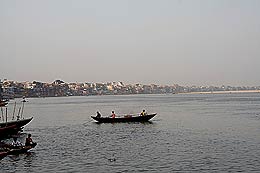 |
...His wife was sold to a seller of flowers. When his son died
of a snakebite his wife brought him to the burning ghat
where her husband was working. Because she had no money to
pay the cremation fee, she ripped her sari in half to pay
the fee...
|
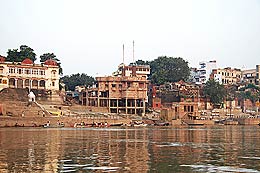 |
...Brahma then restored
the son back to life and gave the king back his kingdom. He
also told Hariscandra that this ghat would be especially
sacred and that it would be named after him. Hariscandra Ghat,
also called Smashan (Masan) Ghat, is a major burning ghat
using electric ovens. |
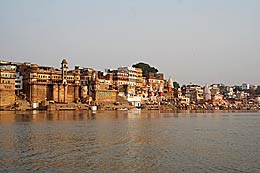 |
Dasasvamedha Ghat
This is the main bathing ghat in town, so it can be extremely crowded.
|
 |
The area around this ghat is the main center of activity in
the city, especially for pilgrims and tourists. This ghat is
full of pilgrims bathing in the holy Ganges.
|
 |
It is said that Lord Brahma performed a Ten Horse Sacrifice
here for king Divodasa. Das means 'ten,' aswa means 'horse,'
and medha means 'sacrifice.' It is said that bathing here
gives the same merits as received by doing the 'ten horse
sacrifice' that were performed here. On certain auspicious
days up to 30,000 pilgrims may take bath here.
|
 |
Manikarnika Ghat
Mani-karnika means "Jeweled Earring." It is said that this
name was given because Lord Siva's earring fell into the well just next
to the ghat.
|
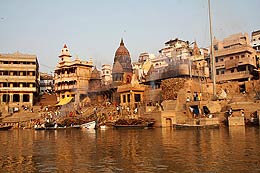 |
Manikarnika Ghat is considered the holiest of all the ghats.
There is a major cremation ground right next to this ghat at
Jalasayin Ghat. Normally the cremation ground is outside of
town, as it is polluted. Here the burning ghat is in the
middle of the city, because death in Varanasi is considered
a great blessing. It is said to be bad luck to mourn or cry
for the dead.
|
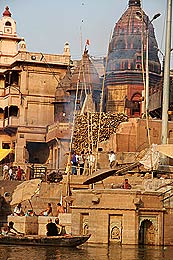 |
The cremation ground is under the supervision of the Doms, an
untouchable caste, who have been doing it for a very long
time. They sell the wood, tend the ever-burning sacred fire
from which each pyre is lit, and tend individual pyres. You
can view the burning ghats from a boat or from a tower next
to the burning place. At any given time there may be half a
dozen bodies burning here. The bodies are first placed in the Ganges
before being burned.
|
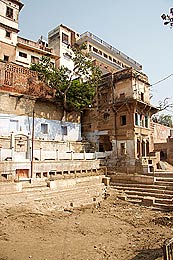 |
Manikarnika Kund is said to be so ancient that it was
present before King Bhagiratha brought the Ganges to
Varanasi. This kund is also called Chakra-Pushkarini Kund or
"Discus Lotus-Pond." The well is said to come from a source
separate from the Ganges, an underground river that comes
directly from Gaumukh, which is the source of the Ganges. It
is said that this well was dug by Lord Vishnu with his disc
(chakra) and filled by water as his first act of creation.
It is said that at one time this kund was a very large lake.
|
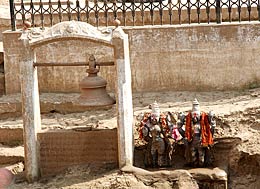 |
There is an image of Lord Vishnu in the northern wall of the
kund. Offerings of milk, sandalwood, sweets, and bilva
flowers, which are sacred to Siva, are thrown in the well.
|
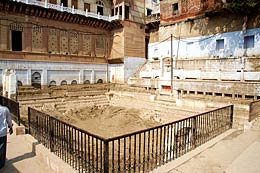 |
In October or November,
there is a good chance the kund will be covered by dirt,
because when the Ganges floods during the rainy season
(June-Sept), dirt from the Ganges covers up the kund. The kund
is dug out each year in November. |
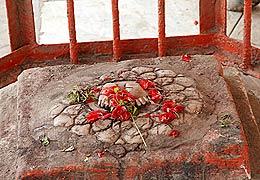 |
Lord Vishnu's footprints are located at Chakra-Pushkarini,
which is between Manikarnika Kund and the river...
|
 |
...This is said to be the holiest spot in Varanasi.
|
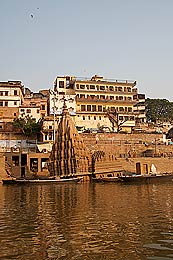 |
At the very big Scindia Ghat...
|
 |
...there is a partially submerged Siva temple. Agni, the god
of fire, is said to have been born near this ghat
|
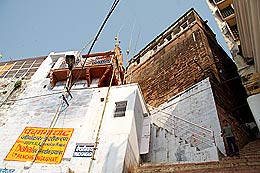 |
Pancha-ganga Ghat
Beneath this ghat the Ganges, Yamuna, Sarasvati, Kirana, and Dhutapapa
Rivers are said to meet. It is one of the five main ghats in Varanasi.
It is considered especially auspicious to bathe here during the month
of Karttika (Oct-Nov), and even more so on the full moon day of
Karttika.
|
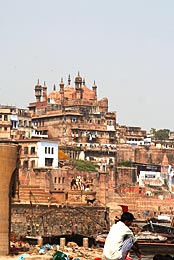 |
At this ghat is the large Alamgir Mosque built by Aurangzeb in
the 17th century, after he destroyed the major Bindu Madhava
Temple that used to be here.
|
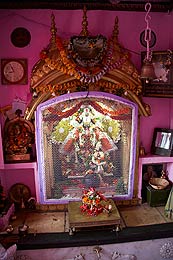 |
The present Deity of Bindu Madhava is in a small temple
by the mosque.
|
 |
It is located just above the Pancha-ganga Ghat. If you are
taking a boat by yourself, you can have the boat stop here
and walk up to the temple.
|
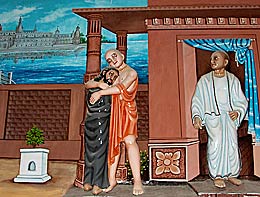 |
Sri Caitanya Mahaprabhu bathed at Pancha-ganga Ghat
and visited the old temple of Bindu Madhava. While staying
in Varanasi on His way back from Vrindavan Sri Caitanya
became the guest of Tapana Misra and Candrasekhara. It was
here that he met Srila Sanatana Goswami...
Sri Caitanya also converted Prakasananda Sarasvati and his
followers while staying at Varanasi.
|
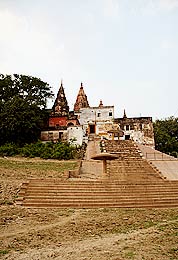 |
The Adi Keshava Vishnu Temple is located where the Ganges
meets the Varuna River, in the north of town.
|
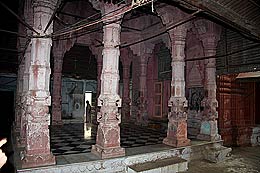 |
Tulasi Das translated the Ramayana from Sanskrit into Hindi in
Varanasi, and there is a temple in his honor.
|
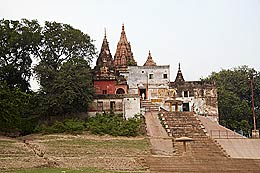 |
Lord Vishnu is said to have first put his feet here when he
came to Varanasi.
|
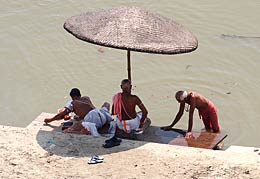 |
Millions of pilgrims a year come to Varanasi. The three most
important ghats are Manikarnika, Dasaswamedha, and
Pancha-ganga.
|
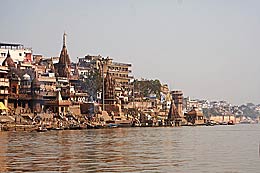 |
To bath at these three ghats is called Tri-tirtha Yatra. Also
important are Asi Sangam and Varuna Sangam. To bathe in
these five places is call Pancha-tirtha Yatra. You are
supposed to bathe in these five ghats in a certain order.
First you bathe in Asi Ghat, then Dasaswamedha Ghat, then
the ghat by the Adi Keshava Temple near the Varuna River, then
Pancha-ganga, and then Manikarnika...
|
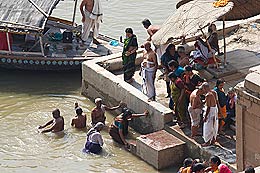 |
...After taking bath at these five places, most pilgrims then
go for darshan of Visvanath, Annapurna, and Sakshi Vinayaka
(the witnessing Ganesh)....
|
 |
...It is said that if you bathe in these five places, all in
the same day and in this order, you will not get another
material body. You can do Pancha-tirtha Yatra by boat, but
it is better to do it by foot.
|
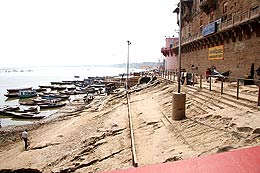 |
In October, the ghats are so covered by mud brought by Ganges
waters...
|
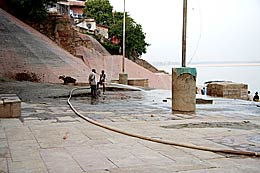 |
...that they have to be literary excavated every year.
|
 |
In the old part of the city there are numerous mazes of thin,
very crowded streets, which makes the place very interesting.
|
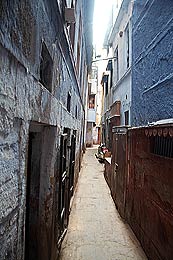 |
The streets are so narrow, that one can easily get lost here..
|
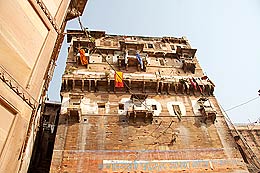 |
..and has to go to the ghats to find out where he actually is.
|
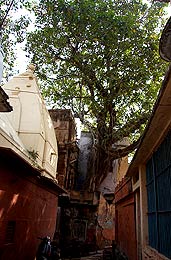 |
Varanasi was looted numerous times by Muslim invaders
beginning from the 11th century. Aurangzeb destroyed most of
the temples during his reign in the 17th century...
|
 |
...This is why most of the temples are not more than 300 years
old. In 1669 the Bindu Madhava Vishnu Temple and the Siva
Visvanath Temple were destroyed. Mosques were built in their
place.
|
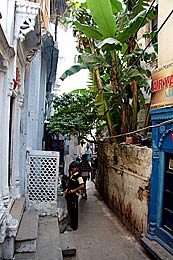 |
The Panchakroshi road goes around the city of Varanasi. Many
pilgrims walk the 58km around Varanasi starting at
Manikarnika Ghat. They then walk to Asi Ghat and then
proceed around the city...
|
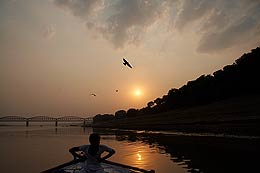 |
...You are supposed to visit 108 shrines along the way.
Following this procedure is said to be the same as circling
the entire world.
|
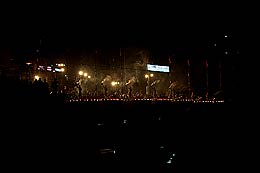 |
Ganga-puja is performed every evening on Dasasvamedha
Ghat.
|
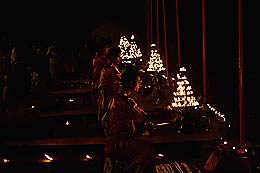 |
Circular gheelamps...
|
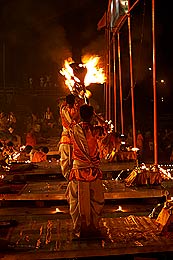 |
...and those with snake's hoods...
|
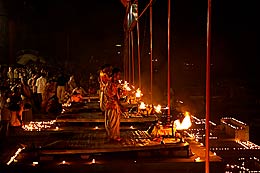 |
...are offered first to mother Ganga...
|
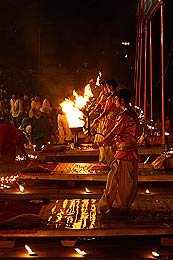 |
...and than to different directions...
|
 |
...and as the puja is slowly ending...
|
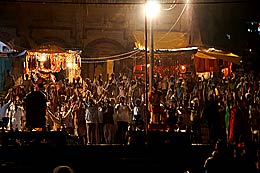 |
...people and pilgrims are joyfully worshipping the holy river
Ganges...
|
 |
...which flows so graciously...
|
 |
...by the side of the holy city of Varanasi.
|

























































